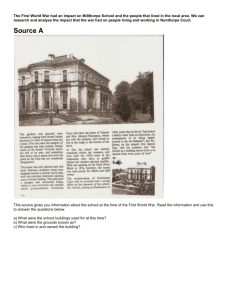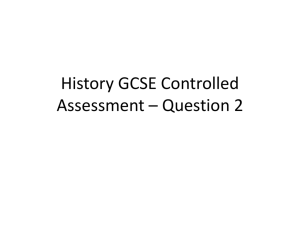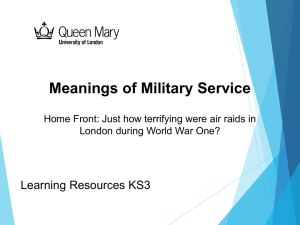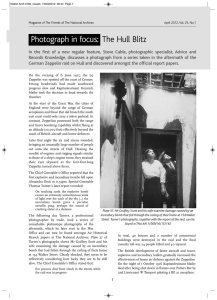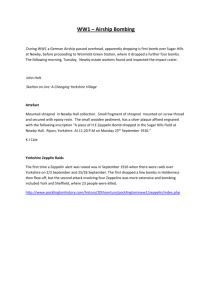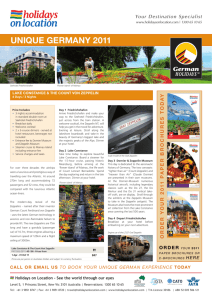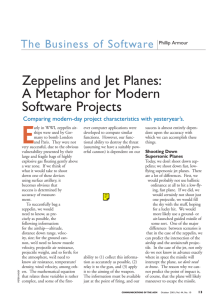The Zeppelin Raids civilians?
advertisement
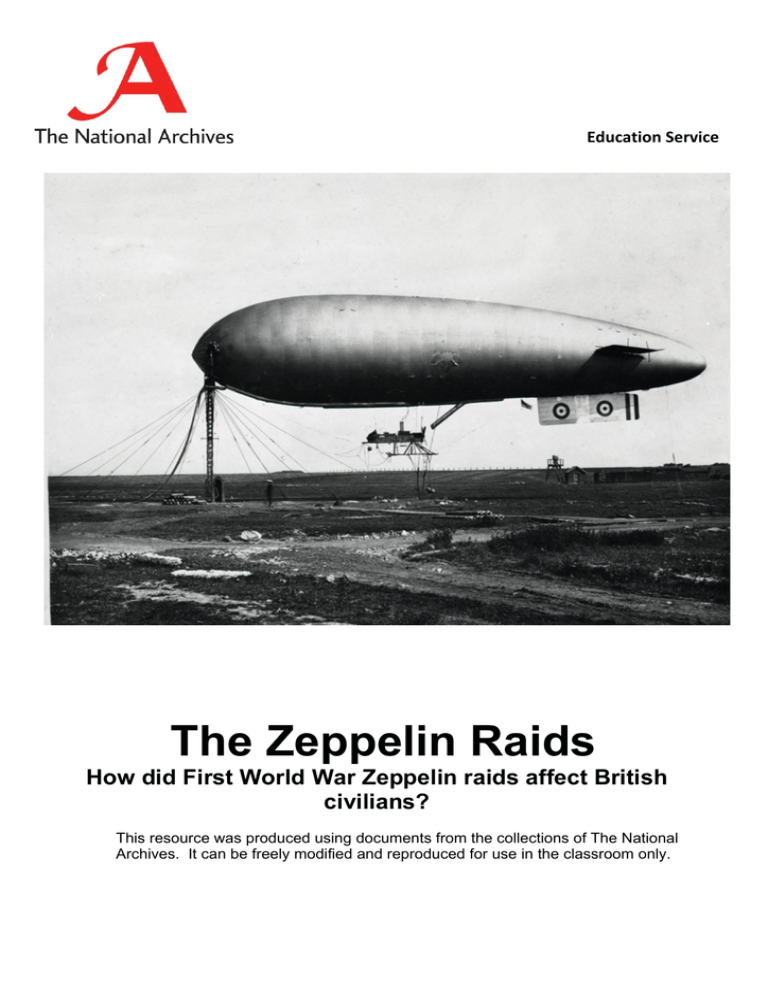
Education Service The Zeppelin Raids How did First World War Zeppelin raids affect British civilians? This resource was produced using documents from the collections of The National Archives. It can be freely modified and reproduced for use in the classroom only. The Zeppelin Raids : How did First World War Zeppelin raids affect British civilians? 2 Introduction Before the 20th century, civilians in Britain had been largely unaffected by war. Previous overseas wars rarely touched British shores. World War One was to change all that. Historians have described it as a "total war", a global war which involved both civilians and the armed services on a massive scale. Count von Zeppelin, a retired German army officer, flew his first airship in 1900. They were lighter than air, filled with hydrogen, with a steel framework. When the war started in 1914, the German armed forces had several Zeppelins, each capable of travelling at about 85 m.p.h. and carrying up to 2 tons of bombs. With military deadlock on the Western Front, they decided to use them against towns and cities in Britain. The first raid was on Great Yarmouth and King's Lynn in January 1915. These documents refer to a Zeppelin raid on Hull in June 1915. Tasks Look at Source 1 1. This is a report of the raid by Major General Ferrier, Commander of the Humber Defences. a) Find out the basic facts of the raid. Note down: the date, the times when the raid started and finished, how many Zeppelins took part, what direction they were travelling. b) What kind of bombs seem to have been used? c) How did some people in Hull react to the raids? d) Why do you think they reacted in this way? e) How did Major General Ferrier deal with this situation? Look at Source 2 2. Read this diary of events and report of action taken, by Major Robert Hall, Fire Commander Humber Defences. a) When did the Fire Commander receive his first information about a raid? b) What weapons were used to try to shoot down the Zeppelin? c) How effective were they? Why? 3. At the end of his report, Source 1, Item 17, Major General Ferrier refers to a separate letter giving suggestions for "what is in my opinion urgently required." After reading Sources 1 and 2, what do you suggest would improve the defences of British cities and their civilian population?. © Crown Copyright 2008 The Zeppelin Raids : How did First World War Zeppelin raids affect British civilians? 3 Look at Source 3 4. This is a photograph of damage caused by the raid to Edwin Place, Porter Street, Hull. 3 people were killed and several injured here. a) In what ways does this source add to our understanding of the raid on Hull? b) Which of these three sources do you find most useful for finding out about the raid? c) The Zeppelin raids of 1915 brought death to ordinary civilians, in their own homes. Was this a new feature of warfare? d) Use your knowledge of the First World War and this lesson to explain the meaning of the concept of "total war". Background Lighter than air flying machines were successfully developed before aeroplanes. Count von Zeppelin was impressed by their potential and built his first successful airship in 1900. From then, civilian airships developed rapidly before World War One. Passengers travelled in considerable comfort in gondolas slung underneath the huge 190 metre-long hydrogen-filled rugby ball-shaped balloon. They had more space than in many modern aeroplanes and could stroll about admiring the view. The German Army and Navy both saw the potential that airships had for reconnaissance. They were used almost from the opening of the war for getting information by flying over enemy lines far above gunnery range. As it became clear that the war would be long and drawn out, Zeppelins were sent to bomb British cities. Their route was over the North Sea from their bases on the north west German coast. The early raids caused lots of damage and many civilian casualties. At first, as these documents show, British defences were totally inadequate to deal with the Zeppelin threat. However, by 1916 a range of anti-airship defence measures were introduced. Many more guns were deployed, and searchlights. Fighter aircraft were also sent against them. British defences learnt to pick up their radio messages, so had warning of their approach, and a central communications headquarters was set up. It was realised that Zeppelins were extremely vulnerable to explosive shells, which set light to the hydrogen, often in spectacular fashion. Zeppelin raids were called off in 1917, by which time 77 out of the 115 German Zeppelins had been shot down or totally disabled. Raids by heavier than air bombers continued, however. By the end of the war over 1500 British citizens had been killed in air raids. The vulnerability of Zeppelins to explosive shells, and their relatively slow speed, led to rapid development of heavier-than-air machines. By 1918 both sides were using large numbers of aeroplanes, not just for reconnaissance, but as fighter air support and as bombers. Air war, and the threat it brought to the lives of civilians, had become part of 20th century warfare. © Crown Copyright 2008 The Zeppelin Raids : How did First World War Zeppelin raids affect British civilians? 4 After the war both Britain and Germany continued to develop airships for passenger services, offering a much more roomy, comfortable service than early aeroplanes could provide. However, the spectacular crash and fire of the R101 in 1930 discredited this form of air flight. Teachers Notes Second World War air-raids are one of the most powerful British memories of the 20th century. This lesson shows that attacks on civilians from the air began in the First World War and were quite serious. The focus of the tasks is on the drama and damage, the impact on civilians and British inability to deal with the raid. It would fit into investigations of: • • • Changing technology and warfare, showing how new inventions completely change the way war is waged. The Home Front. The story of the Zeppelin raids is part of the story of the mobilisation of the British people in the First World War. Civilians and total war. The 20th century introduced the British people to 'total war'. From comfortable security on the island, with war taking place elsewhere, the British people were thrown into the front line. In the Second World War and the Soviet nuclear threat of the Cold War this is obvious, but it starts with the Zeppelin raids of the First World War. Sources Illustration : AIR 11/241 Sources 1 - 3 : AIR 1/569/15/16/142 Schemes of Work Hot war, cold war why did the major twentieth-century conflicts affect so many people? Key Stage 3, Unit 18. © Crown Copyright 2008 The Zeppelin Raids : How did First World War Zeppelin raids affect British civilians? 5 Source 1 : Report of the raid by Major General Ferrier, Commander Humber Defences 1915 (AIR 1/569/16/15/142/A) © Crown Copyright 2008 The Zeppelin Raids : How did First World War Zeppelin raids affect British civilians? 6 Source 1 : Transcript of Report of the raid by Major General Ferrier, Commander Humber Defences 1915 (AIR 1/569/16/15/142/A) 1:- Information was received at 7.25 p.m. that two Zeppelins were in the North Sea. I attach a copy of the important messages received during the night = "A". 2:- At 9.30 p.m. I ordered all lights to be extinguished in Hull. 3:- At 11.47 p.m. Hedon, six miles from Hull, reported Zeppelin coming to Hull, and almost immediately, the engines were heard in my telephone office. My Staff Officer went outside the Hotel and saw a Zeppelin over head, very distinct against a clear sky, at a height estimated by him as 3,000 feet. He saw three bombs dropped. As each one left the Zeppelin the airship was clearly lit up. He then reported to me, and I heard five explosions, and I saw from my window that two fires had started. 6:- At 12.30 a.m. Brig.General Dixon reported several fires, one serious, which threatened Holy Trinity Church, several casualties, but all details working very well. Paull reported that the Zeppelin had passed over at 12.15 a.m. going S.E. - counted 32 bombs dropped in Hull City. 7:- All arrangements for collecting wounded and extinguishing fires worked very well. Great credit is due to the troops and fire brigade for saving Hold Trinity Church, which was only 27' away from Messes. Davis large establishment, which was burnt to the ground. 10:- From reports received I am of opinion that there were two Airships in the vicinity of Hull, but only one dropped bombs. 12:- The casualties up to date are 19 (5 men, 9 women & 5 children) killed, 24 seriously wounded, and 40 cases dealt with at dressing stations and sent to their homes. 17:- In conclusion I beg to state, I am submitting seperately a letter giving my suggestions as to what is in my opinion urgently required in view of other raids. © Crown Copyright 2008 The Zeppelin Raids : How did First World War Zeppelin raids affect British civilians? 7 Source 2 : Diary of events and report of action taken, by Major Robert Hall, Fire Commander Humber Defences 1916 (AIR 1/569/16/15/142/B) © Crown Copyright 2008 The Zeppelin Raids : How did First World War Zeppelin raids affect British civilians? 8 Source 2 : Transcript of Diary of events and report of action taken, by Major Robert Hall, Fire Commander Humber Defences 1916 (AIR 1/569/16/15/142/B) 8.40 p.m. 6th Message received from C.R.A. as follows:-m "Following from Headquarters begins - 'Admiralty reports "zeppelin reported at 7.5 p.m. in the North Sea sean about 100 "miles East of Humber. Tonge lightship reports that the Boulogne "wireless is receiving from two Zeppelins there are in the "North Sea and seen to be proceeding towards England' message ends The above was dispatched 8.53 p.m. to all Batteries. 11.50 p.m.6th Bomb explosions were heard in the direction of Hull. Rifle fire heard in the direction of Sallingborough whilst bomb dropping was going on. 12.10 a.m. 7th Red glare in sky seen in a North-Westerly direction, taken to be flames. 12.15 to 12.25 a.m. 7th Zeppelin in ful sight from the Battery, direction North west to South -East down the river. 12.20 a.m. 7th Sunk and Stallingborough Batteries opened fire with Maxims. Number of rounds fired from Sunk being 152, & Stallingborough 49. 12.21 a.m. 7th Pom-poms heard to open fire at Killingholme or Immingham About this time a red rocket was sent up from the Examination vessel and also hooting was heard either from the Boom boats of the Examination vessel. 12.30 a.m.7th The following message sent by F.C. from Sunk to C.R.A. and Headquarters Humber Defences - "Zeppelin passed over Battery between 12.15 and 12.25 a.m. Sunk and Stallingborough Batteries opened fire 12.20 a.m. Killingholme 12.21 a.m. Effects of fire not seen as Zeppelin was flying high towards Grimsby" About 12.30a.m. 7th. Rifle firing and one explosion heard in the direction of Grimsby, We could get no communication by either telegraph or telephone to Hull from the time the explosions were heard at 11.50p.m. 6th, till the Zeppelin was seen at 12.15 a.m. 7th over the Battery. From two approximate angles taken from the tip of the P.W.S.S. at the time the Zeppelin was passing, the height of the Zeppelin was approximately 10,000 feet. One reading gives just below 10000 ft. and the other reading just over. It is obvious therefore that the fire from our M.guns could not possibly be effective. Glossary: Maxim: a machine-gun; pom-pom: nickname for a machine-gun © Crown Copyright 2008 The Zeppelin Raids : How did First World War Zeppelin raids affect British civilians? 9 Sunk: gun battery 5 miles south east of Hull. Stallingborough: gun battery 10 miles south east of Hull; Killingholme, Immingham: gun batteries 8 and 9 miles south east of Hull. CRA = Commander, Royal Artillery © Crown Copyright 2008 The Zeppelin Raids : How did First World War Zeppelin raids affect British civilians? 10 Source 3 : Photograph of damage caused by the raid to Edwin Place, Porter Street, Hull. 1916 (AIR 1/569/16/15/142) © Crown Copyright 2008

